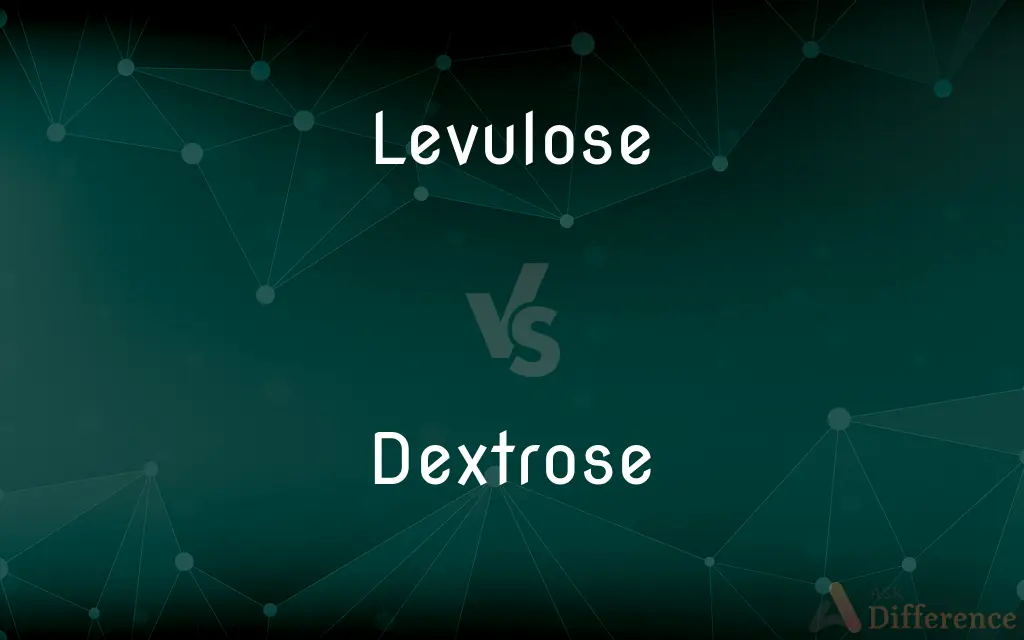Levulose vs. Dextrose — What's the Difference?
By Maham Liaqat & Fiza Rafique — Updated on April 16, 2024
Levulose, or fructose, is a simple ketonic sugar found in fruits, whereas dextrose, known as glucose, is a primary energy source in cells.

Difference Between Levulose and Dextrose
Table of Contents
ADVERTISEMENT
Key Differences
Levulose, also known as fructose, is naturally found in honey, tree fruits, berries, and most root vegetables, while dextrose, or glucose, is present in starch-rich foods like bread, rice, and pasta. Both sugars are monosaccharides and important energy sources, but they differ significantly in their sources and structure.
Levulose has a sweeter taste compared to dextrose, making it a common additive in the food industry to enhance sweetness while using less sugar overall. Dextrose is less sweet but is often used for medical purposes, such as in intravenous solutions to increase sugar levels quickly.
In terms of health implications, excessive consumption of levulose can lead to liver diseases and other metabolic disorders. Conversely, dextrose, while essential for cellular function and energy, can also contribute to health issues if consumed in excess, such as diabetes and obesity.
The metabolic pathways for levulose and dextrose also differ; levulose is metabolized in the liver using the fructolysis pathway, whereas dextrose is processed through glycolysis which is pervasive in most body cells. This metabolic difference further underscores their distinct impacts on human health.
Comparison Chart
Basic Structure
Ketonic sugar
Aldose sugar
ADVERTISEMENT
Found in
Honey, fruits, some vegetables
Bread, rice, pasta, starch sources
Sweetness
Sweeter than dextrose
Less sweet than fructose
Metabolic Pathway
Metabolized mainly in the liver
Metabolized in various body cells
Compare with Definitions
Levulose
Metabolized primarily in the liver.
Excessive intake of levulose can stress liver function.
Dextrose
Derived from starches, like corn or wheat.
Corn syrup is a rich source of dextrose.
Levulose
Associated with health risks when consumed in high amounts.
High levulose consumption can lead to metabolic syndrome.
Dextrose
Essential for cellular energy and function.
Dextrose is crucial for producing ATP in cells.
Levulose
Naturally occurring in fruits and is very sweet.
Apples are a good source of levulose.
Dextrose
A simple aldose monosaccharide sugar that is a major sugar.
Dextrose is often used in medical settings to quickly elevate sugar levels.
Levulose
A simple ketonic monosaccharide sugar; found in many plants.
Honey contains high levels of levulose.
Dextrose
Overconsumption can lead to health complications.
Chronic high intake of dextrose may contribute to obesity and diabetes.
Levulose
Does not rapidly raise glucose levels.
Levulose is often recommended in moderate amounts for some diabetic diets.
Dextrose
Quickly raises glucose when consumed.
Snack foods high in dextrose can cause sugar spikes.
Levulose
See fructose.
Dextrose
The dextrorotatory form of glucose (and the predominant naturally occurring form).
Levulose
(carbohydrate) D-fructose, the left-rotating stereoisomer of fructose
Dextrose
The dextrorotatory form of glucose, C6H12O6·H2O, the naturally occurring form of glucose found in all organisms. Also called dextroglucose.
Levulose
A sirupy variety of sugar, rarely obtained crystallized, occurring widely in honey, ripe fruits, etc., and hence called also fruit sugar; also called fructose. Chemical formula: C6H12O6. It is called levulose, because it rotates the plane of polarization of light to the left, in contrast to dextrose, the other product of the hydrolysis of sucrose.
Dextrose
The naturally-occurring dextrorotatory form of glucose monosaccharide molecule.
Levulose
A simple sugar found in honey and in many ripe fruits
Dextrose
A sirupy, or white crystalline, variety of sugar, C6H12O6 (so called from turning the plane of polarization to the right), occurring in many ripe fruits, and also called glucose. Dextrose and levulose are obtained by the inversion of cane sugar or sucrose, and hence the mixture is called called invert sugar. Dextrose is chiefly obtained by the action of heat and acids on starch, and hence called also starch sugar. It is also formed from starchy food by the action of the amylolytic ferments of saliva and pancreatic juice.
Dextrose
An isomer of glucose that is found in honey and sweet fruits
Common Curiosities
How does levulose affect health?
While it is safe in moderation, excessive levulose intake can lead to liver diseases and other metabolic disorders.
How does the body process levulose differently from dextrose?
Levulose is primarily metabolized in the liver, unlike dextrose, which is metabolized through glycolysis in various cells.
What is levulose?
Levulose, or fructose, is a type of simple sugar naturally found in fruits, honey, and some vegetables.
What is the primary dietary source of levulose?
The primary sources are fruits, vegetables, and honey.
Is levulose sweeter than dextrose?
Yes, levulose is generally considered sweeter than dextrose, which is why it's used in smaller quantities to achieve the same level of sweetness.
Can dextrose be naturally found in foods?
Yes, it naturally occurs in starchy foods and is also added to many processed foods for energy.
What are the sources of dextrose?
Dextrose is derived from starch-rich foods like cereals, bread, and corn syrup.
Is levulose suitable for diabetics?
In moderation, it can be a part of a diabetic diet, but its consumption should be carefully monitored.
What is the chemical difference between levulose and dextrose?
Levulose is a ketonic sugar, while dextrose is an aldose sugar, differing in their chemical structure and the way they are metabolized in the body.
What are the industrial uses of dextrose?
Dextrose is widely used in the food and pharmaceutical industries, especially in baking and as a sweetener in processed foods.
Why is levulose considered a risk for metabolic syndrome?
Due to its unique metabolism in the liver, excessive intake can lead to increased fat production and metabolic disturbances.
Share Your Discovery

Previous Comparison
Gaze vs. Glance
Next Comparison
Anthem vs. MotetAuthor Spotlight
Written by
Maham LiaqatCo-written by
Fiza RafiqueFiza Rafique is a skilled content writer at AskDifference.com, where she meticulously refines and enhances written pieces. Drawing from her vast editorial expertise, Fiza ensures clarity, accuracy, and precision in every article. Passionate about language, she continually seeks to elevate the quality of content for readers worldwide.














































